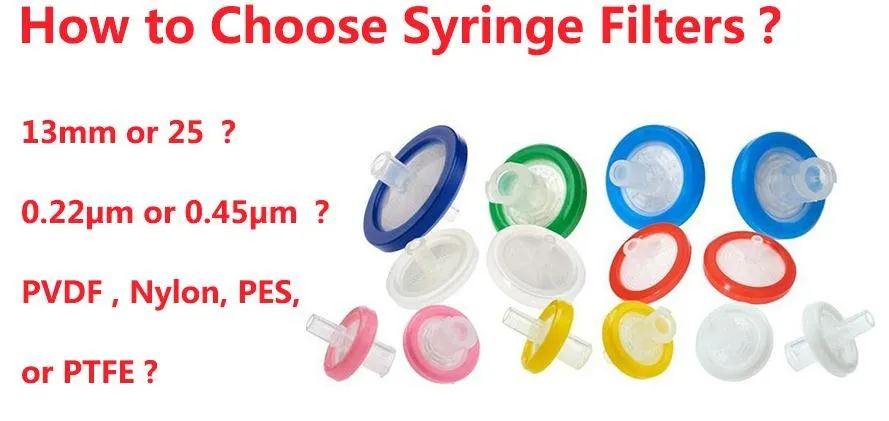
A syringe filter, also known as a wheel filter due to its shape, is used to remove particles or impurities from a sample prior to analysis, in order to prepare a solution for HPLC. They are also used for purifying or sterilizing culture media. The filter cartridge can remove particles that could damage narrow-bore equipment.
Syringe filters are designed for single-use convenience, speed, and performance. They cannot be reused because the fine particles are too small to be seen by the naked eye and could lead to cross-contamination, potentially affecting the results.
There are different types of syringe filters available, which differ in size, porosity, material, and chemical resistance.
For hydrophilic samples: use hydrophilic filter membranes that have an affinity for water and are suitable for filtering solutions with water as a matrix. Available filter membranes include mixed cellulose ester, polyethersulfone (PES), Nylon, etc.
For highly corrosive organic solvents: use hydrophobic filter membranes, such as PTFE, polypropylene (PP), and other materials.
For protein solutions: select filter membranes with low protein adsorption, such as PVDF filter membranes.
For ion chromatography: PES filter membranes are generally considered suitable for filtering solutions with low inorganic ions.
To learn more about the characteristics and applications of filter membranes, please check a guideline of the difference between these types of filter membrane.
Pore size refers to the space between the pores. Some common pore sizes include 0.2 microns, 0.22 microns, and 0.45 microns.
0.2 microns are suitable for mycoplasma and other small microorganisms. This size flows slower.
0.22 microns are usually used for disinfecting solutions by removing viruses and bacteria and preparing gases for high performance liquid chromatography (HPLC). This size will exclude most microbial contaminants, other than mycoplasma.
0.45 microns are used for purifying solutions containing high concentrations of particles. This size is suitable for clarification.
Pore size indicates the particle size that can pass through the filter. Filters with various pore sizes can be used to both clarify solutions by removing particles and sterilize by preventing contamination, fungi, and bacteria. Two different filters can even be layered for simultaneous clarification and purification.
The size of the syringe filter should match the sample volume you are filtering.

Sterile syringe filters are used for filtering samples that need to be free from microbial contamination (such medical applications).
If a sterilized solution needed, sterile syringe filters come individually wrapped to ensure optimal performance without contamination.
Non-sterile syringe filters are typically used for filtering non-sterile solutions, such as for sample preparation in analytical chemistry.
You can find different types of syringe filters at Aijiren. With a variety of materials, pore sizes and diameters according to your requirements. Check all of our Syringe Filters here.
| Syringe Filter Quick Choose Guide | |||||||||
| 1. Choose a Suitable Membrane Type | |||||||||
| Characteristics of Samples | |||||||||
| Aqueous Solution | Organic Solution | Protein Solution | Highly Corrosive Solvents | Gas Filtration | |||||
| Nylon | PES | CA | PTFE | PVDF | |||||
| PES | MCE | PVDF | PTPFE | ||||||
| MCE | PVDF | ||||||||
| PTFE | PTFE | ||||||||
| 2. Choose the Suitable Pore Size | |||||||||
| According to the particle size | According to micron size of columns | ||||||||
| <0.2um | >0.2um | <3um | >3um | ||||||
| 0.22um(bacteria removal) | 0.45um | 0.22um(bacteria removal) | 0.45um | ||||||
| 3. Choose Suitable Syringe Filter Diameter | |||||||||
| Volume of Samples | |||||||||
| <10ml | <100ml | <250ml | |||||||
| 13mm | 25mm | 33mm | |||||||
| 4. Sterile or Non-sterile | |||||||||
| Sterilize Solutions or Clarify Sterile Solutions | General Filtration and Sample Purification | ||||||||
| Sterile | Non-sterile | ||||||||